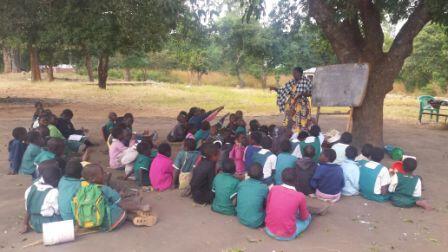
When going towards the South West of Lilongwe in Traditional Authority (TA) Malili, one comes across a school which is surrounded by 20 small villages with over 80 households in each village.
Zapita is one of the villages where many people’s source of income is brick moulding and small scale farming. The settlement which is headed by a female Group Village Headperson (GVH) Zapita is housing a school that adopted her name.
Most children who go to the school come from poor households, which can be evidently seen living in dire poverty. It can be proved beyond reasonable doubt that they are living below the poverty line as most households depend solely on free social services such as Farm Input Subsidy Programme (FISP).
Like other villages elsewhere in the country, children from the settlements begin school in large numbers, but they also drop out from school handsomely due to a number of reasons, chief among them being poverty and lack of parental care.
Although there are a number of initiatives the Malawi government put in place to alleviate dropout challenges in primary schools, studies have exposed that there is an increased number of learners dropping out of school.
Realising the extent to which learners drop from school, the Civil Society Education Coalition (CSEC) commissioned an investigative study with financial support from Individuell Mannskohjalp (IM) to establish its root causes.
Swedish Development Partners through their programmes have been actively working in Malawi with its local partners for over 10 years to tackle poverty at individual level.
The study showed that 97 learners against the enrolment rate of 992 dropped out of school during the 2016/2017 academic calendar.
Out of 97 dropouts 49 were boys and 48 were girls mostly ranging between 6 and 14 years old.
The study also revealed that dropout rate for 2016/2017 academic year was high in Standard One with 13.9 percent and Standard Two with 12.7 percent. It slightly dropped in other classes while it rose again in Standard 7 with 7.8 percent and Standard 8 being the highest with 33.7 percent.
On the same trend, dropout rate for 2017/2018 academic year recorded 76 learners dropping against an enrolment of 926 of which 39 were boys while 37 were girls. Standard one alone recorded 11.6 percent with Standard Two at 10.4 percent. The drop out also slightly changed in the other classes but rose again in standard 8 at 13.3 percent.
Zapita Primary School head teacher Likagwa Mussah argued in an interview that high dropout rate is worrisome at the school because most parents or guardians let their children go scot-free with their decisions to stop going to school even if they are not mature enough to make such decisions.
He said: “We had a school feeding programme in 2016/2017 academic year. We also have a ‘changing room’ at this school which female learners use when they are in periods. The problem is that there is lack of parental care and guidance to let children remain in school.”
Mussa’s statement confirmed sentiments which one of the parents Yohane Symon made in an interview saying that he let her girl child get married than going to school because he believes it is her right to cherry-pick what she wants in her life.
“I have my first born daughter who was in Standard Eight before she got married. I did not say anything when I learned that she got married to a certain man. I could not say anything on that because that is what she chose and it is her right,” said Yohane.
However, according to the study, 13 dropouts who were interviewed mentioned that they left school because they could not manage to pay for school development fund which the head teacher confirmed is currently pegged at K350 per term.
Chrissy Stephano, who is one of the dropout girls intoned that she left school because her guardian could not manage to provide for school uniforms, notebooks and fees, a statement which reflects the general situation regarding dropouts.
During the community engagement meeting, which chiefs, parents and community stakeholders attended at Zapita, Lilongwe District education chairperson Hardwell Jani, who is also Councillor for Chiwamba ward in Lilongwe North East constituency bemoaned lack of political will in implementing deliberate policies aimed at promoting education in the country.
GVH Zapita and Village Headman (VH) Chilinda also acknowledged that there are many boys and girls who dropped from school in their villages.
The two chiefs said they are failing to enforce community by laws because many parents and guardians blast the community leaders when pressurized to send their children to school.
According to 2017 Education Management Information System report, National average dropout rate in primary school is at 48 percent annually.
This development seem to threaten the attainment of United Nations (UN) Sustainable Development Goal (SDG) number four which is to compel UN member states to ensure inclusive and equitable quality education and promote lifelong learning opportunities for all.














